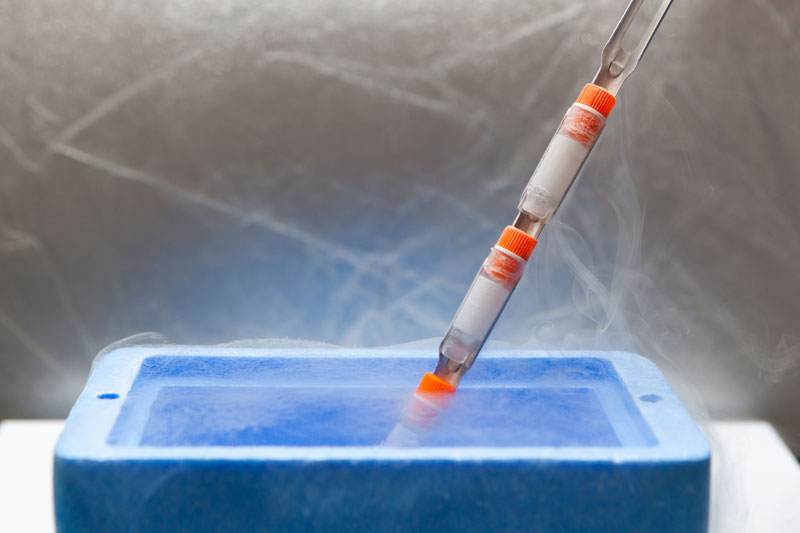Gaining access to the cell is a prerequisite to establishing infection. Replication, however, is when a virus subverts the cell to generate multiple copies of itself. The nature of the virus genome determines the steps required to reach this stage. Positive-stranded RNA viruses are immediately translated into proteins, before replicating their genome through a negative strand intermediate. Negative-stranded RNA viruses must first be transcribed into a positive strand form; the information encoded by DNA viruses needs to be transcribed into mRNA, while retroviruses come as positive-strand RNA viruses and are reverse transcribed into DNA that will integrate into the nucleus. Hepatitis B virus has an even more complex pattern, as it comes is as single-stranded DNA and needs to become double stranded and circularised in the nucleus, before been transcribed into mRNA.
These differences often require researchers to use specific assays to investigate the various stages of viral replication. But in this blog, we will describe some of the more general techniques that we employ to detect virus translation and replication. As a bonus, we also explore the power of viral replicons.
Studying replication: the toolbox
As for viral entry, fluorescence microscopy is a potent tool to detect viral replication. Most viruses tolerate the insertion of fluorescent proteins, which will only be expressed once the virus is actively replicating. However, even when tagged viruses are unavailable, antibodies against viral proteins can be used to detect virus replication, as even the staining of structural proteins will be very distinct from the punctate and low-intensity staining of the incoming virus. By tagging the right protein or using the right antibody (not all viral proteins remain within the replication complex!), it is also possible to determine exactly where replication occurs. Flaviviruses, for instance, can be clearly seen at the ER, while a cytosolic cluster of replicating virus can be seen for Alphaviruses or Vaccinia virus. To visualize the replicating genome itself, fluorescence in situ hybridization (FISH) is a valid alternative. FISH uses fluorescent probes complementary to the viral genome to allow visualization of either incoming and replicating virus, or just replicating virus when designed against the complementary strain.
Biochemistry techniques often rely on the incorporation of radio-labeled nucleotides (viral replication) or methionine (viral translation), as well as Western blots. For some viruses, reporter systems can indicate whether cells have been infected. HeLa TZM-bl cells are an engineered HeLa cell clone that expresses the human HIV receptor/co-receptors CD4, CCR5, and CXCR4. HeLa TZM-bl cells also encode HIV-1 Tat-regulated reporter genes for firefly luciferase and ß-galactosidase, allowing rapid detection of infected cells expressing Tat.
qRT-PCR remains among the principal techniques for measuring viral replication. qRT-PCR is popular because of its ease of implementation, requiring only the design of primers (for Sybr Green) or primers + probes (for Taqman); its extreme sensitivity; and the possibility to accurately quantify the number of viral copies. As for any sensitive technique, high accuracy and good lab practice are required, as well as the inclusion of adequate controls for each step of the process. Primer validation is also necessary for accurate quantifications: doubling the amount of DNA should translate into a decrease of exactly one PCR cycle: if this is not the case, the difference should be taken into account in the calculations.
Replicon systems
Replicons are modified viral genomes where the structural proteins have been removed so that the virus is still able to replicate but cannot generate new infectious progeny. The clear advantage of these systems is that they can be used at lower containment than the parental viruses. Furthermore, replicons provide an extremely useful system when viral entry and spread to other cells are not of interest or may confound the results. For instance, if we need to confirm that a compound blocks the viral polymerase, an inhibitory effect on the replicon suggests that inhibition of entry, assembly, or spread are not involved. Replicons can be used by transfecting a cell line each time, or by making stable cell lines. Transient transfection is ideal when a more physiological situation is required, as it avoids system adaptation or the selection of cells that simply better tolerate the replicon. Stable transfection requires the expression of a selection gene (either a drug resistance gene or a fluorescent marker for cell sorting) and is more convenient as it bypasses the need for poorly efficient transfections. However, whether this can be implemented depends on their cytopathicity.
Beyond the virus
Virus replication is probably the process that most affects the host cell. To allow for replication, the innate immune response has to be inhibited, the cell translational machinery recruited (often to the detriment of cell protein expression), the metabolic activity of the cell subverted to generate virus components, the cell structure remodeled, and sometimes, the entire transcriptional program recoded to the virus’ advantage. All this is also visible and quantifiable.
At VRS, we have experience measuring viral replication, as well some of the many effects that replication has on the infected cells. From qRT-PCR to high-content imaging, we can determine and quantify the consequence of infection and assess whether a treatment or a restriction factor attenuates or reverts these effects in the cell system of choice.
Contact us to discuss your research needs and start to explore the full picture (in high-resolution!)




